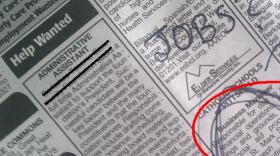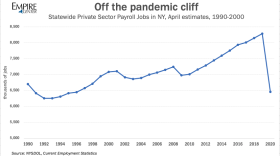A business survey finds with employees returning to workplaces, employers are planning for workforce growth at a time when hiring has become more difficult.
According to the latest Alaant Hiring Index released this week, employers are hiring and optimistic about further job growth as the economy recovers. But overshadowing those expectations: 4 of 5 employers surveyed say they can’t find qualified candidates.
Alaant's Miriam Dushane noted a majority of employers, 51%, said hiring is up from last year; 60% expect it to continue to rise in 2021; and 70% are either very optimistic or optimistic about job growth.
At the same time, 78% of employers characterize hiring as either a significant challenge or challenging – up from 55% last fall – and only 20% see it as improving, which is half as many as last fall. Dushane says this isn't a new theme: there was a short supply of qualified candidates for employment before the pandemic.
As the COVID-19 pandemic eases, nearly half of Capital Region companies have returned to in-office schedules; Rise in hiring, future optimism is threatened by a significant recruiting challenge, fueled by a shortage of qualified candidates, according to Alaant.
"A lot of workers took a step back, they have reevaluated what types of jobs they want to have, when they want to work, how they want to work. And it is having an impact on the applicant flow, and the workers that are putting themselves into the arena for employers to possibly recruit for their organizations."
Alaant found nearly half of employers, 47%, have returned to regular in-office schedules; similarly, employers with a majority of employees working remotely dropped from 56% last fall to 42% in the spring. For companies that have not returned to in-office schedules, 28% expect to do so over the summer and 14% in the fall or winter, with the comfort level of employees the most important factor in their decision. And, exactly half of companies expect to remain a hybrid workforce, with a mix of office and remote employees.
“What we're finding is when employees or potential employees are applying for jobs or we’re recruiting them, one of the questions probably one of the top three questions they're asking is, ‘is there any type of flexibility in the work arrangement?,’ meaning that a lot of times workers are looking for a hybrid work approach. So they're not really looking for 100% remote work, they're looking for a hybrid, which would allow them to work in the office a few days, but also work remotely a few days. So I think a lot of workers got used to the ability to work from home. Many employers, including myself personally, found that remote workers were just as productive if not more productive, working remotely.”
Dushane adds some employers may not be able to allow as much flexibility as other organizations, so they may not compete as well for those workers to fill their positions. And as recovery continues, there's another consideration:
“Employees are looking for more money, things are a little bit more expensive than they were a year and a half ago. And frankly, employees are looking to increase their wages and we're seeing that coming through. When you know, we're looking for a job making, you know, let's say $20 an hour, as compared to a job that might be offering a pay between 25 or $28 an hour, and it could be a similar job in a similar industry. Obviously, there's more applicants for that higher paying job. But even without posting the salary or the wage for that position, when we're talking to candidates, they absolutely are increasing their demand or their target salaries that they're looking for.”
Responses to the Alaant Workforce Solutions survey were gathered between May 5 and 28 from 98 hiring and human resource managers, evenly split between Capital Region companies with more or less than 100 employees.







